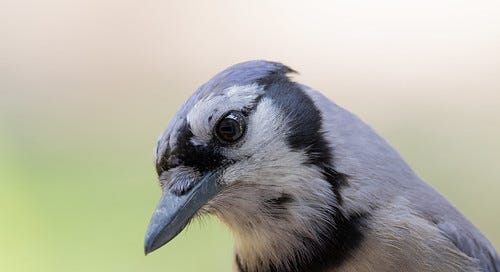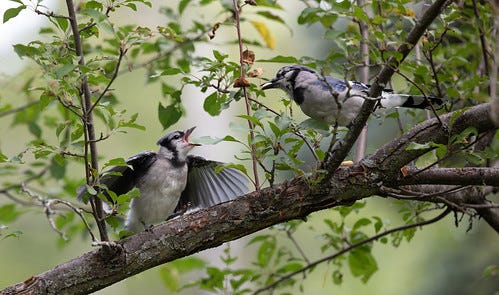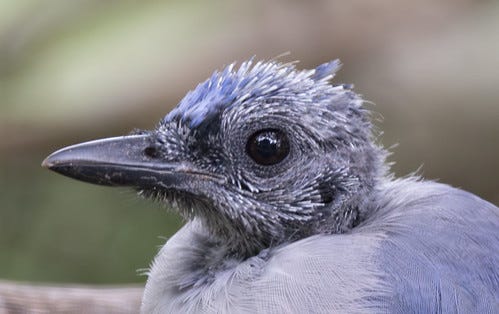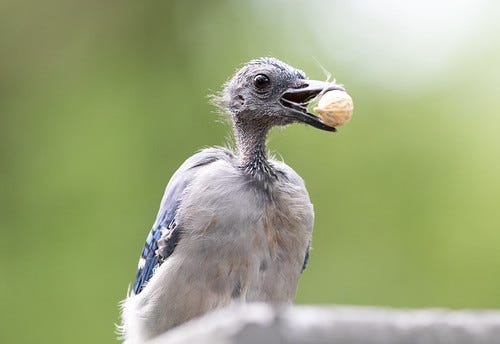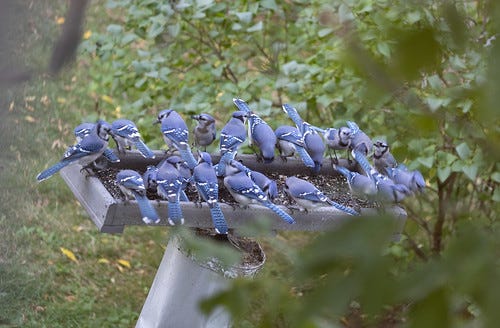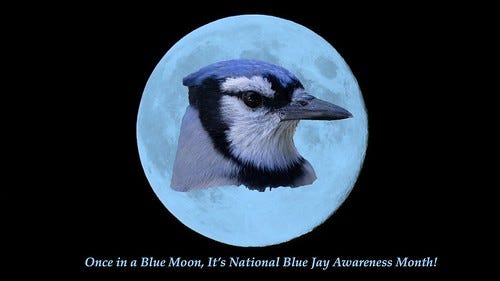(Listen to the radio version here when I post in September 18.)
I define a Blue Moon as a second full moon within a calendar month, which we had on August 30. I started producing “For the Birds” in May 1986, and missed the first Blue Moon after that, in May 1988, but ever since December 1990, I’ve named every month with a Blue Moon “National Blue Jay Awareness Month,” usually doing lots of programs about jays. On August 10, I promised blog readers that I’d produce at least a few blog posts and podcast episodes about Blue Jays to honor this year’s National Blue Jay Awareness Month, but the end of August has come and gone with nary another word about Nature’s Perfect Bird.
When I realized I’d dropped the ball, I thought the reason might be me. I know I’m getting a little forgetful, being 71 years old now. Alternatively, I could blame my little grandson —I babysat for Walter just about every weekday all month. When I’m with him, I don’t think about much else, and then when I get home I’m pretty pooped.
But no—as it turns out, it wasn’t my fault at all—it was all because Blue Jays don’t approve of being celebrated in August, period. I figured this out when I heard from Mark in Connecticut. He wrote:
I continue to try to get photos of the Blue Jays I share my yard with, but at this time of year, while they are still flying with their fledglings and just getting a bit less stand-offish, it is hard to get photos. I think it is all due to their social embarrassment of being Nekkid as a Jay Bird…
My word, but Jays do not like to be seen without their plumage. I looked up the phrase Naked as a Jay Bird on the Internet and found it was adapted from European expression of Naked as a Robin. I don’t have any European Robin experience, so I do not know what they do behind closed nest doors, but I can only imagine.
As for the Jays, their lack of head feathers causes them to rarely stop on the porch railing. They swoop in for peanuts and swoop out without saying thank you.
Of course that’s it! Most of the National Blue Jay Awareness Months I’ve celebrated in the past have fallen in December, January, or March, when Blue Jays are looking their very best. Of course they cooperate with people celebrating them then! But adult jays spend late spring and early summer nesting, their babies dependent on them until well into July. By then the parents’ feathers are over a year old, but they don’t start molting until they get to keep all the food they find instead of giving the lion’s share to their young. Then it takes over a month to replace those old feathers with gorgeous new plumage.
So Mark is right—Blue Jays don’t want us to focus on them too much during the molt, especially those adults who molt all their head feathers at once. As Mark notes, it’s tricky to take photos of them during this time.
During the height of the pandemic when I was home-bound, I did manage to persuade one nice jay into giving me a few photos, strictly for educational purposes, during its awkward molt. Yes, I paid for those modeling services in peanuts, but I’d built up a trusting relationship with that one over a couple of years, and I assured it I’d never, EVER use those photos to embarrass or ridicule it—simply to explain to people that molt patterns vary among individual Blue Jays.
My education Blue Jay Sneakers, who lived with me in the 90s, always molted all her head feathers in late summer, a quick process. Meanwhile, BJ, another Blue Jay I lived with for years, molted his head feathers one by one. I wouldn’t have noticed he was molting at all except that I happen to be allergic to bird feathers, and his dropped feathers floated around my home office for weeks after Sneakers was good as new.
By September, most jays are done with all that and at the peak of their fall migration up here. In the past few years, it’s been easy to see dozens in my yard at almost any moment on September days. In 2021, I photographed 24 crowded into my 3-foot tray feeder.
So far this year, I haven’t have any huge collections of Blue Jays in my yard because I’ve been invaded by a flock of pigeons who descend on the feeders the moment I fill them. But I have seen plenty of jays flying over. Two years ago, in the fall of 2021, the counters at Hawk Ridge broke their all-time record for Blue Jays, tallying 59,601 over the season. Last year they broke that record with 60,523. This year, they’ve already smashed that record, with 65,170 counted through Sunday, September 17. (You can keep up with this year’s count data here.)
So Blue Jays seem to be taking charge of their own publicity, no longer depending on my silly National Blue Jay Awareness Month to garner attention from their admiring fans. That’s just as well. The next Blue Moon will happen on May 31, 2026. Assuming my 74 ½ year old brain remembers, I’ll call it National Blue Jay Awareness Month, but no matter whether I remember or not, whatever month it is, Blue Jays are here to stay.


